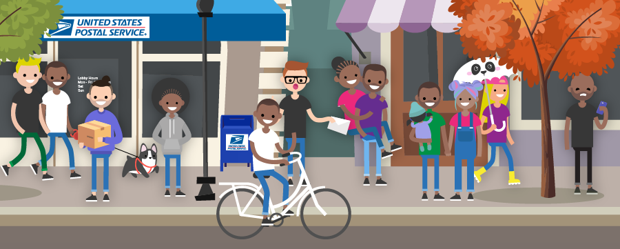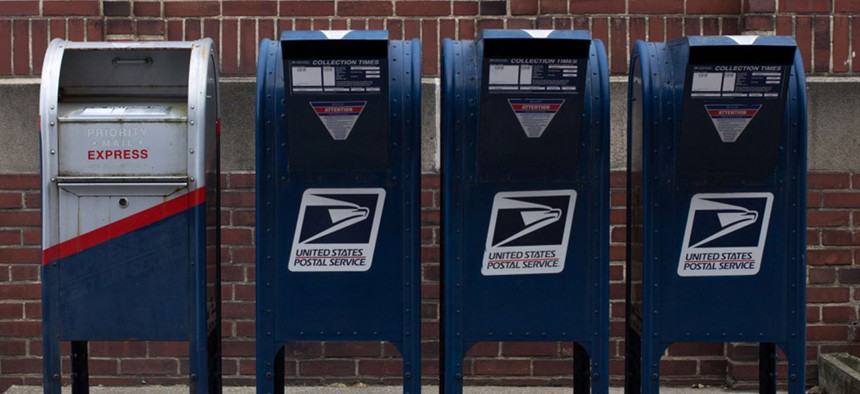One Thing Millennials Aren’t Killing: The Postal Service
A new USPS report suggests young adults aren’t as disengaged from snail mail as you might think. In fact, it makes them feel special.
One reason snail mail feels so good to receive is because it wasn’t easy to send. When a letter lands in your mailbox, you know the mailer put thought into it—writing a note, scrounging up stamps and an envelope, and seeking out a blue box to drop it in. Paradoxically, it’s that same effort that makes the U.S. Postal Service less and less appealing to use.
It shouldn’t surprise anyone to learn that the rise of the internet hasn’t been great for the Postal Service. Americans are sending less mail than they used to, with overall volume falling 43 percent since 2001. That decline is especially pronounced among Millennials. In 2001, Gen X-ers between the ages of 18 and 34 received 17 pieces of mail per week. By 2017, that number fell to 10 pieces of mail for Millennials in the same age range.
The financial toll has been significant, too—to the tune of $2.7 billion in losses in 2017. While e-commerce has been a boon, with package deliveries expected to raise USPS’s total revenue by half a billion dollars this year, that growth comes alongside a steep decline in first-class mail, which includes letters and postcards. That part of the business is projected to fall $800 million this year.
As the Postal Service scrambles to stay afloat, it’s hoping those two weak links—young people and personal mail—hold the answer to success in the future. And a new report from the USPS Office of the Inspector General suggests it might not be so hard to pull off.
Getting personal
The key, it seems, is to focus on feelings. While pen pals and fan mail aren’t the cool traditions they once were, the OIG report bets that the emotional sentiment behind them can be bottled up and repackaged. In fact, 75 percent of survey respondents said receiving personal mail “made them feel special”—and we all know how much Millennials are supposed to like that.
Moreover, USPS market research shows that even though younger Americans send and receive less mail, they feel pretty good about the Postal Service overall: 80 percent of Millennial respondents said they were either somewhat or very satisfied with USPS. Still, only 44 percent pick up mail at least six days a week, compared to 60 percent among Gen X and 73 percent among Baby Boomers.
How to bridge the generation gap? To really understand how to reverse the decline of mail use among young people, postal historians say you must first understand how it came to be popular in the first place.
At the birth of the Postal Service in 1775—when Ben Franklin was appointed the first postmaster general—few people used it except for merchants, who were wealthy and important enough to send things long distance. It became a more common way of staying in touch by the second half of the 19th century, when rates went down.
But it wasn’t until the invention of Valentine’s Day in the 1840s (yes, it’s always been a Hallmark Holiday) that young people got interested in sending notes to their beaus. “It was a young person’s appropriation of the medium,” said Richard R. John, a Columbia Journalism School professor who wrote Spreading the News: The American Postal System from Franklin to Morse.
Then there was the postcard, introduced in the early 1870s. “It was promoted as a way to send really quick messages, sometimes in code, if you care about such things,” said Dianne DeBlois, an ephemera dealer and collector. With the advent of Rural Free Delivery in the 1910s and 1920s, people who lived along the same rural delivery routes would use postcards to invite friends over for tea later that day, or to dances later that night. But anything that went through the mail in postcard form was restricted in size and automatically made public. Even gossiping via postcard was a libelous offense, because anyone could see it.
What attracted young people to all these mediums was that they were tactile, they were fun, they were reasonably quick, and they were personal. But one day, an invention disrupted them all: not email, but the telephone.
“The key shift there… was the Bye Bye Birdie culture of the 1950s and 1960s,” John said. Friends were now calling each other up on landlines to share gossip, not sending postcards along rural mail routes. “Phones are very fundamentally different than letters because the telephone is synchronous”—meaning you’re talking to each other in tandem, not waiting for a response—“but there was a desire to be in touch via the phone probably from post-WWII and through the ’90s and on.”
Something to hold on to
Still, the desire to hold notes close has never gone away. Even the telegram, developed in the late 19th century, didn’t become the new social outlet some expected. “When you get the telegram, you don’t have the evidence of the physical presence of the sender,” said John. “People did not conduct love affairs or intimate long-term correspondences via telegram.” (The large-type STOPs probably helped kill the vibe.)
Email hasn’t killed romance, obviously. You’ve Got Mail showed just how titillating the swoosh of a new digital message could be, even between two bookstore owners who ostensibly loved the feeling of paper.
But servicemen and -women abroad crave mail just as they did during World War II. Now, loved ones can send emails to the military through the post office, and the service will promise to print the messages out. “It’s so they can have something to fold up and put in their pockets,” said DeBlois.
It’s that desire for the physical that the post office needs to capitalize on, says Amanda Stafford, who co-wrote the OIG report. While Millennials like paying bills online, they prefer giving and receiving birthday cards the old-fashioned way.
“If you want to send something to your girlfriend that no one else can read—something she can hold on to—even, good heavens, a print photograph she can put under her pillow, you should mail it,” DeBlois said.
Snail mail, but tech-savvy
But survey respondents also want the post office to adapt to a more technological world. They like convenience, self-service options, and advanced notice of mail delivery. They want a rewards program, like the one at their local coffee shop. If the post office wants to engage the next generation of mail users, they’re going to have to reconcile the tension inherent in these findings, says John Althen, the other co-author. “The effort is intrinsically valuable, but that doesn’t mean that the process can’t be frictionless.”
An extreme version of the post office digitizing the personal is its experimentation with augmented reality. Grandma could send a recording of her singing “Happy Birthday” along with a card; or colleges could accept you with a letter and an admissions video. “If there was a way to make postcards or actual cards have an augmented reality like that I would consider using the USPS much more often,” one respondent said. “I would look forward to receiving advertisements in the mail from companies that would use that.”
And while things sometimes get lost in the mail, at least they aren’t as susceptible to NSA surveillance. As data breaches and Russian hacks get more common online, DeBlois says the Postal Service could encourage young people to use mail as a more secure alternative: “Your snail mail isn’t going to be hacked.”

Mail time! (USPS OIG)
A new generation
A less promising finding showed that Millennials’ level of engagement with the mail service correlated closely with their living arrangements. Those who co-habitated with a partner were 44 percent more likely to send personal correspondence than those who lived alone, with parents, or with roommates. Bonus points for Millennials with kids, who were 57 percent more likely. That demographic is shrinking, though: In 1975, 57 percent of 18- to 34-year-olds lived with a married spouse; in 2016, it was only 27 percent.
The solution for USPS might be “getting engaged with them at several points of their life,” Althen said. If Millennials are renting more, they’re moving more. What many of them don’t know is that the Postal Service will send you online coupons for things like home decor when you file for a change of address.
I am the worst kind of Millennial—one who loves to get mail, but is loathe to send it. I don’t own a single stamp, nor one envelope. My dad, a Gen X-er, has several of both on hand, and takes pride in this fact. He volunteers at a fire department, where everyone has to take an annual physical. When he asks young officers to self-address an envelope so they can receive a copy of their blood test results, they stare at him blankly. “They don’t even know how to address an envelope,” he tells me—not in a crotchety way, but with a sort of awe. “How did this happen?”
Because of my own mail phobia, I was a bit skeptical of the OIG’s findings, so I conducted an informal Twitter poll asking my followers (many of them Millennials) if they keep stamps around. I expected most of the answers to mirror my own, which is “no, and I am a disappointment to my family.” But almost everyone said they did: In their offices, wallets, and drawers; Forever stamps, Peanuts-themed, and scratch-and-sniff; for rent checks and for fun. My neighbor offered to lend me some if I was ever so inclined.
Maybe some of this was confirmation bias—only the ones that could prove they were stamp-carrying adults wanted to chime in. But it also speaks to the hopes of the Postal Service: Millennials haven’t totally forsaken it, and some even take pride in it.
“You can blame Millennials for a lot of things,” said John, who is 59 years old and has a teenaged daughter. “But you can’t blame them for killing mail.”
NEXT STORY: What It Would Take for Iran to Talk to Trump



